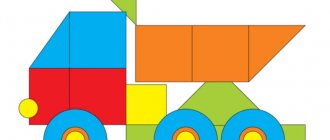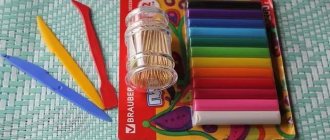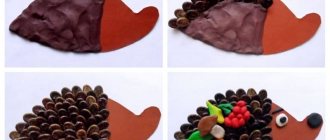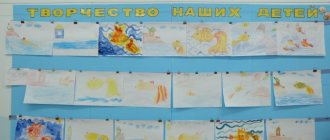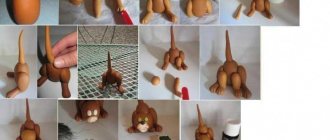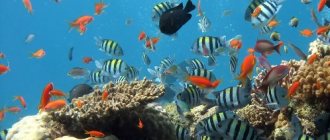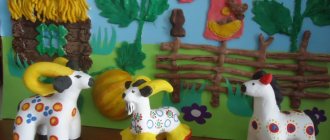Abstract of the educational activity “Fish swim in an aquarium” Purpose: To create conditions for the development of the ability to pinch off a small piece of plasticine, roll it into a ball and flatten it on paper. Objectives: - Continue teaching children to pinch small pieces of plasticine from a piece and roll them into balls. Press the ball with your index finger, attaching it to the base. Deepen children's knowledge about the life of fish. — Develop memory, thinking, attention, speech, fine motor skills of the fingers. — Cultivate interest in nature and display of impressions. Materials: plasticine, fish cut out of paper, image of fish in an aquarium. Integration of areas: social-communicative, cognitive, physical development. Progress of GCD 1. Organizational moment. - Guys, guess the riddle: A clean silver back shines in the river. Who is this? (Fish) - Now let's play: I will pronounce pure phrases, and you will repeat after me. Yes, yes, yes, the fish are in trouble in the water. Yes, yes, yes, the whale is swimming here. (Children repeat after the teacher) 2. Motivational moment. We look at illustrations of fish. - Guys, look at what body parts do fish have and what shape? (All fish have an oval-shaped body, triangular fins and a tail covered with scales, eyes, a mouth). - What size are the fish? (Big and small). - Are the fish the same color? (I draw attention to the colors of the fish: bright, beautiful). - In what direction are they swimming? (The fish swim in different directions: up, down, right, left.) - Guys, what can’t a fish live without? (This is water).- Do you know where the fish lives? (In a river, in the sea, in an aquarium).- So, the fish has a body, a tail, fins, eyes, a mouth; it is covered with scales. Fish can be large and small, multi-colored, spotted, striped. They swim in the water in different directions: up, down, right, left. There may also be algae, pebbles, and soil in the aquarium where fish can hide. — Do you want to create your own aquarium and put fish in it? 3. Explanation of working methods. We have different fish on the table. Take a close look at what our fish don't have? That's right, no scales. Together we will decorate our fish with colorful scales. We will make them from salt dough. Pinch off a small piece of dough from a large piece. Then we roll it into a ball. Press the ball with your index finger and attach it to the fish. The result is scales. 4. Summing up. - Well done! What beautiful fish you got! And now you will place them in our aquarium.
Attached files
Progress of the lesson:
Guys, listen up! (The sound of the sea surf sounds). What is this noise? This sea is noisy. What is the name of our sea? Black Sea. Let's imagine that we left the kindergarten and came to the seashore. Above our heads we have a blue sky with clouds, golden sand under our feet, and in front of us is the sea. How beautiful it is all around!
And how many words can you find if you look closely and think. After all, words can be found everywhere.
I will find words everywhere - And in the sky, and in the water, On the floor, on the ceiling, On the nose and on the hand. Haven't you heard this? No problem! Let's play a word game!
Didactic exercise “Find words”
Find the words in the sky. (Clouds, birds, wind, clouds, plane, lightning, blue, sun.)
Find words in the sea. (Water, wave, fish, algae, storm, crab, dolphin, jellyfish, ship.)
There are many different fish that live in the sea. There are fish that are edible for humans. Fishermen catch them, and we buy, cook and eat them. These are anchovy, herring, gobies, horse mackerel, and flounder. There are dangerous fish. They can prick with a poisonous thorn, like the sea cat and the sea dragon; and even give you an electric shock like a stingray. Fishermen do not catch them, because meeting such fish is very unpleasant. All fish have a tail. He serves as their rudder. Fish also have fins. Why do you think fish have fins? The word itself will tell you. Fish need fins to swim. Of course, fish have eyes. What are eyes for? The body of fish is covered with plates - scales.
Guys, listen to a funny poem about how fish love to smile. And don’t just listen, but tell me words.
Didactic game “Give me a word”
If it's a fish, it has a smile. If it’s a fish, it has... (smile). If it is a fish, it has... (smile). If it is a fish, it has... (smile). If it’s a fish, she has... (smiles).
Not only in our sea there is a princess of the sea - a goldfish who can speak in a human voice and make wishes come true. Alexander Sergeevich Pushkin wrote a fairy tale about such a fish. This fairy tale is called “The Tale of the Goldfish.” Listen to an excerpt from this fairy tale, which tells how an old man threw a net into the sea - such a large fishing net for catching fish, and a goldfish fell into this net.
Reading an excerpt from “The Tale of the Goldfish” by A. S. Pushkin
The third time he cast the net, a net came with one fish. With a difficult fish - gold. How the goldfish prays! In a human voice he says: “You, elder, let me go to sea, Dear, I’ll give a ransom for myself: I’ll pay off with whatever you want.” The old man was surprised and frightened: He fished for thirty years and three years and never heard a fish speak. He released the golden fish and said a kind word to it: “God be with you, golden fish! I don’t need your ransom; Go to the blue sea, take a walk there in the open space.”
Now let's play. Come out onto the carpet.
Dynamic pause “The sea is agitated”
The sea is worried once, the sea is worried twice, the sea is worried three times, show me how the fish swim! (Feet shoulder-width apart, swinging arms from right to left, imitating waves)
The fish swam and dived in the blue sea water. They will come together and go their separate ways, and then they will bury themselves in the sand. (Hands in front of the chest with folded palms, running in all directions, bending, moving closer and further apart, squatting).
And now I suggest you draw a goldfish.
Drawing "Goldfish"
Notice what shape the fish's body is? What color is the goldfish? What does the fish have? Showing the progress of the work.
To make the fish beautiful, let's draw its scales. We’ll also draw pebbles and algae so that the fish has a place to hide. Showing the progress of the work. Children doing work with background music. Children lay out their finished works on a common surface.
Guys, do you like the drawings of your comrades? Which drawings did you like? Why did you like them?
Guys, let's get creative. What would happen if a goldfish offered to make our wishes come true? What would you ask a fish? Think! So I would ask the fish for my grandfather to get well soon and not be sick anymore, and for my whole family to go on a long, interesting journey. What are your desires? Children tell their wishes, and the teacher writes them on the back of the drawing.
Teplyakova Maria Vasilievna
Teacher of the All-Russian Cultural Educational Institution NDOU "Kindergarten No. 197 JSC Russian Railways", Krasnoyarsk
Materials for the lesson: plasticine, stacks, modeling board, napkin, toy - fish, beads, shells, ready-made tubes on a stand made of plasticine. Goals and objectives: 1) educational: to teach to convey the distinctive features of fish (torso, eyes, mouth, fins, scales) that have the same shape (oval), but slightly different from each other in proportions (large and small fish). 2) developmental: consolidate previously learned modeling techniques; ; expand children's knowledge about aquarium fish; 3) educational: to cultivate creativity and imagination; learn to finish what you start.
Preliminary work: Examination of illustrations, reading the fairy tale “Sister Fox and the Gray Wolf”, making algae from plasticine together with children; looking at a fish in an aquarium. Progress of the lesson: 1. The teacher gathers the children around him, asks a riddle: “Wags his tail This way and that – “Parents and children And don’t have it, All clothes are made of coins.” And there is no trace." Who do you think this riddle is about? That's right, about fish. Surprise moment: Guys, in our group there is an unusual aquarium, who lives in it, a fish. The teacher asks the children questions: (where do aquarium fish live (in an aquarium); what does a fish have (it has a head, body, fins, scales); what is in the aquarium (stones, algae, shells); what does a fish eat (fish food , worms...); how fish move in the water (tail, fins)). Guys, it’s very boring for a fish to swim alone in an aquarium, let’s make a lot of different fish to make it more fun. To make our pens work better, we will play a finger game:
“The fish are frolicking merrily in clean, warm water. Either they will shrink, they will unclench, or they will bury themselves in the sand.”
Once! Two! Three! Four! Five! Let's count the fish! Fishes swim along the bottom, You won’t catch a single one!
2. Children sit at tables, while sculpting, calm music sounds... Guys, now we will take the most ordinary plasticine and start sculpting. Take a piece of plasticine, using a stack, divide it into 2 unequal parts, so that one part is large and the other small. Roll a large piece into a ball, then roll out a slightly short sausage, pull out the tail, pinch the top and bottom to create a tail. We draw out the head, draw a mouth in a stack, pin one fin on the back, one on the abdomen on one side and one on the other side. Roll 2 small balls for the eyes (you can use beads instead of plasticine). Let's scratch the scales with the stack. Look how wonderful the fish turned out. From the second part (small part) of plasticine, we mold a small fish. What elegant fish you have, funny and all so different, not one like the other. We will attach a large fish to a long tube, and a small fish to a short tube. It's time to move in the residents. The teacher asks the question: “Where will our fish live?” ... Let's put them in an aquarium Which of the children sculpted the fastest (offer to sculpt pebbles for the aquarium or algae) Result of the lesson: Guys, what wonderful fish you got. Who has the biggest, biggest, smallest, little, funny, perky, cocky, cheerful, beautiful... Children, what did we sculpt today? Well done, now our fish will not be bored, she has many cheerful friends.
Alena Turyeva
Scientists have proven that the development of logical thinking, coherent speech, memory and attention is closely related to the development of fine motor skills and coordination of finger movements. The level of development of fine motor skills is one of the indicators of intellectual readiness for school education.
Goal: To teach children to press parts into a plasticine base in a certain order, creating an image; develop an interest in working with plasticine;
Tasks :
1. Artistic and aesthetic development:
Introduce children to an unconventional type of modeling
– pressing peas into plasticine relief.
Instill interest in creative activities;
Develop fine motor skills of the hands;
Develop perseverance, composure, diligence, accuracy and attentiveness
2. Speech development:
Activating a dictionary on a topic
3. Cognitive development:
To consolidate knowledge about the habitat of fish and their structure.
Materials and tools:
Bowls with peas, a bowl with buckwheat, a picture of a plasticine fish
, background music.
Preliminary work: Joint reading of fiction “The Tale of the Fisherman and the Fish”
"
A. S. Pushkin (excerpt)
.
Looking at an aquarium with fish
.
Topic of the week: “My Home”
Lesson 22. House for a bunny and a rooster
(Modeling from plasticine)
Program content.
Strengthen children's ability to bring a product to the desired image using plasticine. Learn to retell fairy tales based on illustrations.
Demonstration material.
Heroes of the fairy tale “Hare Hut” (hare, fox, bull, dog, bear and rooster), two toy houses.
Handout.
A small jar of Rastishka cottage cheese, plasticine, a green cardboard stand, a lining board.
Progress of the lesson
Read the Russian folk tale “The Hare’s Hut” to the children in advance.
At the beginning of the lesson, remember this fairy tale based on the illustrations or dramatize it for the children using toys.
Draw the children's attention to the fact that at the end of the fairy tale, the bunny and the rooster decided to live together. Invite them to make a new house for the heroes of the fairy tale - big and strong.
Place a jar of cottage cheese turned upside down in front of each child.
Children must fashion a door and windows from plasticine and attach them to a jar. Then roll it into a ball, flatten it and attach it like a roof at the top. You can make a pipe on the roof from a column rolled up from plasticine. The house needs to be secured with plasticine on a cardboard stand.
Invite the children to show the resulting houses to the bunny and the rooster. On behalf of the heroes of the fairy tale, thank the children.
Hammerhead shark made from plasticine in stages
Hammerhead specimen
Take 2 pieces of plasticine - gray and white
From a gray piece, form a sausage, one end of which is wider, and the other is elongated and narrowed.
Roll a narrow short sausage, flatten it a little, shape it into a narrow elongated rectangle and attach it to the wide end of the body. The result is the head of a hammerhead shark.
Cover the bottom of the shark's body with white plasticine, this way you will outline its tummy.
Now you need to make a tail and seven fins - 4 small and 3 large. We form circles from the balls and divide them into two parts. From each half we make a small triangle-fin.
We attach two fins on top, two on the bottom and four on the sides and a tail.
We attach the eyes to the side of the hammer head.
Hammerhead fish in finished form.
On the topic: methodological developments, presentations and notes
Teach children to draw using non-standard techniques (drawing with crumpled paper, palms, strips of cardboard, printing with potato stamps and cotton swabs).
Teaching children to cut a square diagonally into two triangles, then one triangle in half again; independently make an image of a fish from triangles. .
summary for the middle group.
1. Exercise children in the technique of working with gouache; Learn to draw using non-standard techniques (drawing with crumpled paper, palms, strips of cardboard, printing with potato stamps and cotton swabs)2. Develop
The lesson is conducted using non-traditional drawing techniques (drawing with crumpled paper, palms, strips of cardboard, printing with potato stamps and cotton swabs).
1. Exercise children in the technique of working with gouache; Learn to draw using non-standard techniques (drawing with crumpled paper, palms, strips of cardboard, printing with potato stamps and cotton swabs)2. Develop
Unconventional drawing technique - with foam sponges.
Irina Kulikova
Summary of a lesson in the “plasticineography” technique in the senior group “Aquarium with fish”
Lesson summary in the " plasticineography "
in
the senior group “
Aquarium with fish ” Continue to teach children to convey in their work the characteristic features of the appearance of fish of different breeds.
Practice sculpting techniques (rolling with straight, circular movements of the hands, smearing, flattening techniques).
Develop compositional and spatial perception.
To develop the skills of careful handling of plasticine .
Examination of illustrations with aquarium fish , riddles about fish, artistic words about fish.
Material for the lesson :
Plasticine , boards, stacks, napkins, cardboard in the form of an aquarium , illustrations of aquarium fish , felt-tip pen caps.
Whale
In 1st grade modeling classes, we offer to model a more complex fish using a template. To make the fish more believable, first tell us a little about it.
Sample figurine of a fish-whale.
Take a piece of blue plasticine and a plastic spatula.
Roll one large ball and four smaller ones.
From a large ball, mold the body of a fish in the shape of a thick leaf, one end of which is rounded and the other elongated and pointed. Form leaf-shaped figures from four small balls.
Attach the tail and fins to the body of the fish.
Turn the craft on its side, cut the plasticine in front, as shown in the picture. The whale has a mouth. Sculpt your eyes.
Using a spatula, draw stripes on the back and fins of the whale.
We make three thin sausages and connect them together on the whale’s head. The result is a fountain of water that the whale releases when breathing.
Finished blue whale specimen.
Clown fish - step-by-step master class
Among the beautiful aquarium fish there is a clown fish. It is characterized by bright stripes on its body. This job is more difficult than the previous ones. We suggest making such a craft with children in the senior group of kindergarten or first grade students.
Take 3 pieces of plasticine - white, yellow and red and a plastic knife.
Form a wide sausage from red plasticine, one end of which is slightly wider than the other.
Roll into small balls. Leave one, and make leaves of different sizes from the rest. Connect two larger ones into a ponytail, make a dorsal fin from four small ones, and a lower fin from the largest last one.
Attach all the parts to the body of the fish.
Using a knife, draw stripes on the tail and fins.
Decorate the fish with yellow stripes of different lengths and widths, as shown in the picture.
Use the end of a knife to make indentations-scales.
Add an eye, cut out a mouth. Your clown fish is ready.
Or this simple master class on sculpting a clown fish.
